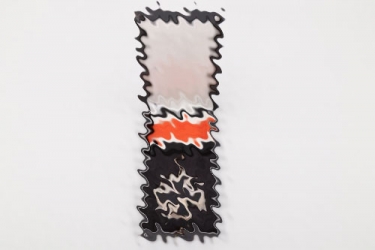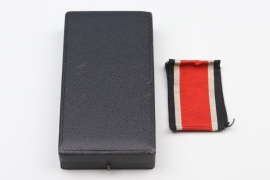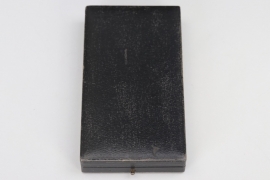3rd USA auction
Die Auktion mit 1172 Losen endete am 19. March 2023. 75% aller Lose wurden verkauft
Oberstleutnant Karl Decker - Urkunde zum Ritterkreuz des Eisernen Kreuzes
Möchten Sie ein ähnliches Stück verkaufen? Wir beraten Sie auch gerne telefonisch: 08541 9053699
-
Bezahlung
-
WIE KANN ICH FÜR MEINE BESTELLUNG BEZAHLEN?
AUKTIONAlle erfolgreichen Gebote werden automatisch zu einer einzigen Bestellung zusammengefasst. Für diese können Sie uns nach Auktionsende in Ihrem persönlichen Kundenkonto Ihre bevorzugte Bezahl- und Versandart oder eine alternative Lieferadresse mitteilen.
Wenn wir diese freiwilligen Angaben nicht von Ihnen erhalten melden wir uns automatisch im Laufe des Montags nach Auktionsende mit einer Zahlungsanweisung per Email. Basierend auf Erfahrungswerten schlagen wir Ihnen die bequemste Bezahlmehtode und die günstigste Versandart vor. Sie möchten Ihre Bezahl- und Versandart ändern oder eine alternative Lieferadresse angeben? Kein Problem! Besuchen Sie Kundenkonto/BESTELLUNGEN oder kontaktieren Sie uns per Email.
BESTELLUNGEN IM ONLINESHOPWählen Sie während der Bestellung Ihre bevorzugte Bezahl- und Versandart und schicken Sie diese ab. Sie erhalten Ihre Zahlungsanweisung spätestens am darauffolgenden Tag per Email. Die Zahlungsfrist beträgt sieben Tage. Sie planen eine Bestellung per Ratenzahlung zu begleichen? Bitte sprechen Sie uns gerne vor Ihrer Bestellung darauf an.
Für mehr Informationen zu Bezahlung und Versand, besuchen Sie unsere Häufigen Fragen.
WIR AKZEPTIEREN FOLGENDE BEZAHLARTEN
-
-
Versand
-
IHRE BESTELLUNG IN DEN BESTEN HÄNDEN
VERPACKUNG & SENDUNGSVERFOLGUNGNach Zahlungseingang versenden wir Ihre Bestellung für gewöhnlich am darauffolgenden Werktag. Wir bestätigen den Eingang Ihrer Zahlung per Email und informieren Sie zur Versandvorbereitung. Nach Abholung der Sendung durch unsere Versanddienstleister teilen wir Ihnen die Sendungsnummer per Email mit. Den Status Ihrer Sendung können Sie auch jederzeit unter Kundenkonto/BESTELLUNGEN einsehen. Ihre Rechnung geht Ihnen automatisch am Tag des Versands zu.
VERSAND ZU EINER ALTERNATIVEN ADRESSEBevorzugen Sie für eine Bestellung einen Versand zu Ihrer Arbeitsstelle? Sie sind im Urlaub und wünschen den Versand zu einer Packstation oder einem Freund? Kein Problem! Diese Änderungen können Sie jederzeit unter Kundenkonto/BESTELLUNGEN vornehmen. Alternativ können Sie natürlich jederzeit auch per Email informieren.
UNSERE PARTNER FÜR DEN VERSAND
-
-
Garantie
-
 GARANTIE!
GARANTIE!Alle angebotenen Artikel werden von unseren Experten akribisch auf deren Echtheit geprüft und detailiert beschrieben. Wir bieten ausschließen zeitgenössiche Originale an. Etwa 15% aller Kundeneinlieferungen ensprechen unseren Anforderungen nicht und werden retourniert.
Gekauft wie gesehen? Nicht bei uns. Im Gegensatz zu traditionellen Auktionshäusern bieten wir volles Rückgaberecht of Originalität an. Sollten Sie mit Ihrer Bestellung nicht zufrieden sein, können Sie die Bestellung innerhalb 14 Tagen widerrufen. Bitte kontaktieren Sie uns vor dem Rückversand. Für mehr Einzelheiten besuchen Sie bitte unsere häufigen Fragen.
In eigener Sache: Bieten Sie nur auf Lose, die Sie auch erwerben möchten. Bitte vermeiden Sie Gebote nach Auktionende zu stornieren. Sollten Sie ein fehlerhaftes Gebot abgegeben haben, informieren Sie uns bitte umgehend. Wir löschen Ihre Gebote gerne bis 24 Stunden vor Ende der Auktion.
-
Land Deutsches Reich 1918 - 1945
Maße 43.8 x 35.5 cm
Gewicht
 US Los US3-0097
US Los US3-0097EAN 3000000016169
 US Los US3-0097
US Los US3-0097Epoche 1918 — 1945
Land Deutsches Reich 1918 - 1945
Material
Maße 43.8 x 35.5 cm
Hersteller
Gewicht
Land Deutsches Reich 1918 - 1945
 US Los US3-0097
US Los US3-0097Maße 43.8 x 35.5 cm
EAN 3000000016169
Hersteller
Gewicht
Deutsches Reich 1918 - 1945
Oberstleutnant Karl Decker - Urkunde zum Ritterkreuz des Eisernen Kreuzes
Beschreibung
Oberstleutnant Karl Decker (November 30, 1897 – April 21, 1945)
Knight‘s Cross on June 13, 1941
466th Oak Leaves to the Knight’s Cross on May 4, 1944
149th Swords to the Knight’s Cross with Oak Leaves on April 26, 1945
Karl Decker joined the 54th Infantry Regiment in 1914 as a wartime volunteer. He was promoted to lieutenant and platoon commander. After the war he was accepted into the Reichswehr, transferred to the 6th Cavalry Regiment in 1923 and promoted to Rittmeister on October 1, 1930. Promoted to major on October 1, 1935, he came to the staff of the 15th Cavalry Regiment. On October 1, 1936, he was promoted to command of the 38th anti-tank battalion and on April 1, 1939, he was promoted to lieutenant colonel. After the Polish campaign, on April 10, 1940, he took over the 1st Division of the 3rd Panzer Regiment. On June 13, 1941, he was awarded the Knight's Cross for his decisive action during the battles for Thermopylae.
“On the April 18, 1941, Oberstleutnant Decker distinguished himself while leading at the head of Kampfgruppe Balck. He and his troops crossed over the Pinios, broke through the Australian/New Zealanders’ fortified line, thrusted towards Larissa and thereby forced the enemy to give up their Olympus position. By smashing the Yugoslavian defense in the Strumica basin he created the necessary conditions for the 2. Panzer-Division’s thrust to Salonika.” (From Traces of War)
On May 15, 1941, he became commander of the 3rd Panzer Regiment, which he led in Russia from October 1941. On February 1, 1942, Karl Decker was promoted to colonel and awarded the German Cross in Gold on August 1, 1942. On September 7, 1943, he was put in charge of the 5th Panzer Division and promoted to Major General on December 1, 1943. On May 4, 1944, Karl Decker was awarded the Oak Leaves for the achievements of his division.
“For the outstanding leadership of the 5. Panzer-Division north of Rogatschew in the period from February 22 to March 21, 1944, and the subsequent relief battles at Kovel. On the morning of the 05.04.1944 contact was established with an outermost strongpoint of Fortress Kovel; the villages of Dubowa and Rudniki (northwest of the city) were taken.” The following press article, dated 08.05.1944, provides further details as to these actions… “At the end of February 1944, the Soviets achieved a penetration north of Rogatschew, and in response the 5. Panzer-Division was thrown into battle in a piecemeal fashion as soon as each Battalion arrived. To buy time for the arrival of further forces Generalmajor Decker created a thin, strongpoint-like defensive front that initially halted the enemy advance. However, on the next day the Soviets attacked the weak elements of the 5. Panzer-Division with 3 of their own divisions. They launched an enveloping thrust through a gap in the German frontline with strong forces and proceeded to a key German position along the Pruth River. To deal with this the divisional commander rushed to the threatened site with a handful of reserves, a few heavy Pak guns, and a Company of Combat Engineers. He set up a defense just before the Soviets arrived and in the ensuing battle, during which he personally fought in the foremost line and positioned the Paks, he and his men defeated all enemy attacks until the arrival of friendly reinforcements. A few days later, on March 02, 1944, the Wehrmachtbericht reported that in this fighting the Silesian 5. Panzer-Division under the command of Generalmajor Decker had outstandingly acquitted itself. This was the second time within three months that Generalmajor Decker and his Division had been named in the Wehrmachtbericht.” (From Traces of War)
On June 1, 1944, he was promoted to lieutenant general. On October 15, 1944, Decker became commanding general of the XXXIX. Army Corps and promoted to General der Panzertruppe on January 1, 1945. After heavy defensive fighting, the corps was moved west in April 1945. When he recognized the hopelessness of the overall situation, Karl Decker took his own life in a forest area near Großbrunsrode near Braunschweig. He was awarded the swords posthumously on April 26, 1945, after being mentioned another two times in the Wehrmachstbericht as the 149th recipient.
The following wartime excerpt describes why Decker received the Swords to his Knight’s Cross… “For the thrust of Panzer-Division Clausewitz under his Korps command. Decker’s mission was to thrust from the Uelzen area towards the south via Helmstedt, with the ultimate aim of establishing contact with the 11. Armee in the Harz. Initial successes were achieved, and these led to the occupation of the bridges over the Weser-Elbe canal at Fallersleben. The Division thereby accomplished its mission of tying down enemy forces and relieving the pressure on our forces positioned at the Elbe River on both sides of Magdeburg.” (From Traces of War)
Knights Cross of the Iron Cross formal award document issued to Oberstleutnant Karl Decker on parchment with an integral blank front leaf, Führerhauptquartier, June 13, 1941. The ornately lettered document is executed in India ink and gold with a hand-inked signature of Adolf Hitler at the bottom. The parchment is just the slightest bit wavy, as is very common in such documents, but otherwise fine condition. Award documents for the Knight’s Cross are rare, even though Hitler granted over 7,000 of them. A severe backlog soon developed and, in the end, very few recipients of the award ever received their large formal award documents.
The document is part of a veteran bring-back that we proudly offer here for the very first time. The GI opted to bring 9 single formal documents in one red presentation leather folder (Mappe) which is offered in this auction (USA LOT US3-0100).
Zustand
1-
Verkäufer
History Trader Inc., 521 Thorn Street #165, Sewickly, PA 15143-0165, USA
NAME
Ritterkreuz des Eisernen Kreuzes
DATUM DER STIFTUNG
1. September 1939 als dritte und neue Stufe des wiederhergestellten Ordens vom Eisernen Kreuz
AUSZEICHNUNGSKRITERIEN
Das Ritterkreuz des Eisernen Kreuzes wurde für besondere Tapferkeit im Angesicht des Feindes und für heraus- ragende Verdienste um die Truppenführung verliehen. Die Verleihung des Ritterkreuzes erforderte die vorherige Vergabe der beiden niedrigeren Stufen. Das Ritterkreuz wurde allein vom Führer auf Vorschlag der Einheit des Soldaten verliehen und vom Heerespersonalamt ausgestellt. Die Ritterkreuze wurden in der Ordenskanzlei in Berlin aufbewahrt, um nach Genehmigung dem Beliehenen zugeschickt zu werden. Vor Ende April 1945 wurden auf keiner Ebene der Wehrmacht Ritterkreuze gelagert.
HERSTELLER
Das Ritterkreuz des Eisernen Kreuzes wurde von sieben Herstellern gefertigt, Varianten innerhalb den einzel- nen Firmen nicht berücksichtigt. Die Ritterkreuze findet man entweder ungestempelt (frühe Juncker und 3/4 Ring Kreuz), mit Silbergehaltsstempel, mit einer LDO-Nummer (L/12 und L/52) und später mit der Präsidialkanzlei- Nummer des Herstellers (2, 20, 65 und 4). Privatverkauf war ab Oktober 1941 verboten.
VERLEIHUNGSZAHLEN
Genaue Zahlen sind nicht bekannt, aber die Schätzungen liegen bei 7.200 und ein paar hundert mehr auf Laager bei der Präsidialkaanzlei.
AUSZEICHNUNGSUNTERLAGEN
Der Beliehene erhielt eine vorläufige Urkunde im Format A5, ausgestellt im Namen des Führers von den zustän- digen Personalämtern der drei Wehrmachtsteile. Die formellen Urkunden (Große Mappe) wurden später aus- gestellt und sind aufgrund des großen Herstellungsrückstandes nur mit Datum Ende 1942/Anfang 1943 zu finden.
TRAGEMETHODE
Das Ritterkreuz wurde mit dem rot/weiß/schwarzen Band als Halsorden getragen. Das Ritterkrreuz wurde im schwarzem Etui und beiliegendem Band verliehen.













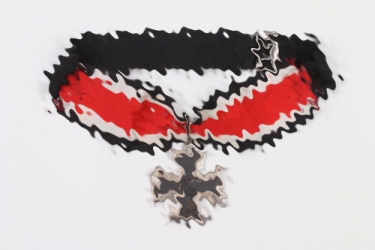


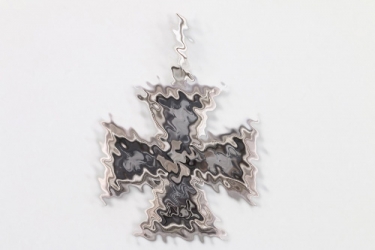
.jpg)

